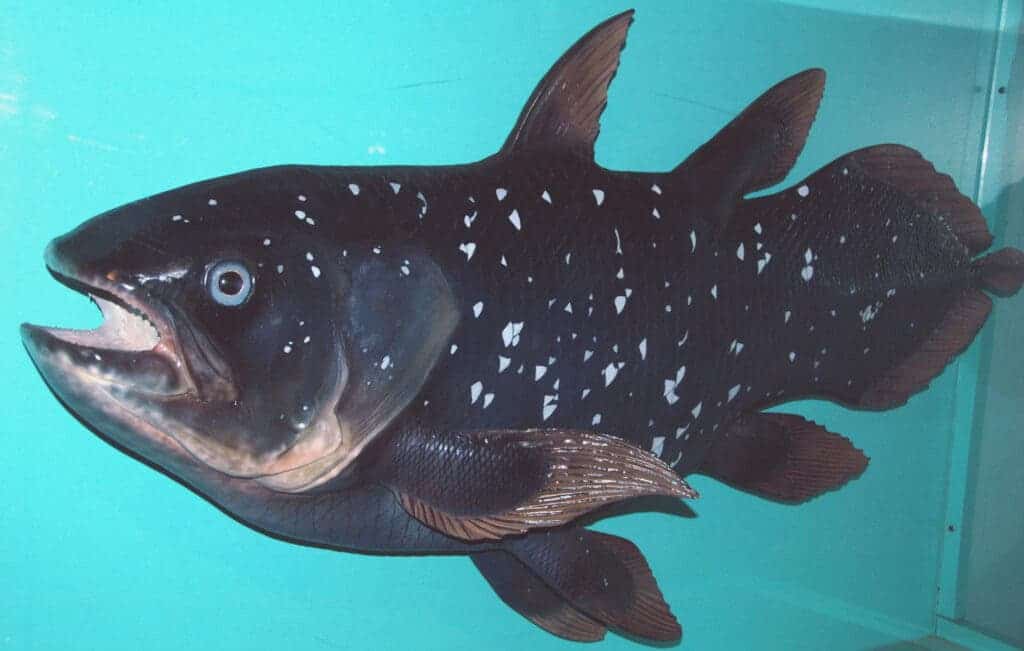The capture of a ‘living fossil’ fish off the coast of South Africa in the 1930s is now helping us understand one of the more exotic ways evolution can happen — interspecies genetic hijacking.

Coelacanths are one of the oldest lineages of fish in existence today. They’re so old, in fact, that they’re more closely related to the ancestors of reptiles and amphibians than modern-day fish. We first encountered them as fossils from the Late Cretaceous (some 66 million years old), and naturally assumed they must’ve died off by now. However, the capture of a live African Coelacanth (Latimeria chalumnae) fish in 1938 showed that it was actually still living in the deep oceans, and had hardly changed compared to its fossilized relatives.
But we should never judge a fish by its scales, as new research explains that the species did in fact gain 62 new genes around 10 million years ago. The most interesting part is how — these didn’t appear spontaneously in their genomes but are ‘parasitic’ DNA gained through encounters with other species.
Genetic stowaways
“Our findings provide a rather striking example of this phenomenon of transposons contributing to the host genome,” says Tim Hughes, senior study author and a professor of molecular genetics in the Donnelly Centre for Cellular and Biomolecular Research at the University of Toronto.
“We don’t know what these 62 genes are doing, but many of them encode DNA binding proteins and probably have a role in gene regulation, where even subtle changes are important in evolution.”
Coelacanths have earned the moniker of “living fossils” because they share so much of their anatomy with the fossilized specimens — in fact, they’re pretty much identical from a physical point of view. But the current findings showcase how gene transfer between species (through elements known as transposons or “jumping genes”) can shape evolution and, perhaps, even alter the genetic trajectory of entire species or lineages.
Transposons are genes that use a self-encoded enzyme to recognize themselves. This enzyme can then cut them out of the genetic strand and paste them in somewhere else. Sometimes, this process can interact with the cell division process and generate new copies of the transposon.
Still, nothing lasts forever, and eventually, the information describing the enzyme degrades. At this point, the transposon can no longer move throughout the code, but it’s still there and acts like any other gene. If it confers some kind of advantage to the host organism, it can be selected for over time through evolutionary processes and become part of their genetic lineage. Coelacanths aren’t by any means the only animals we’ve seen such ‘parasite’ genes in, but they do have a very high number of such genes.
“It was surprising to see coelacanths pop out among vertebrates as having a really large number of these transposon-derived genes because they have an undeserved reputation of being a living fossil,” says graduate student Isaac Yellan who spearheaded the study.
“The Coelacanth may have evolved a bit more slowly but it is certainly not a fossil.”
The team was actually studying counterparts of a human gene, CGGBP1, in other species. We knew that this was a legacy of a particular transposon in the common ancestor of mammals, birds, and reptiles. During their work, the team found CGGBP-like genes in some but not all fish species they studied, and one type of fungus. Worms, molluscs, and most insects had none. But the Coelacanth (whose genome was sequenced in 2013) had 62.
As a common ancestry was out of the question, the team concluded that these transposons entered various lineages at various times in history through horizontal gene transfer. We don’t exactly know where they came from, but one known documented source of such transfers are parasites. This would also explain why the gene was introduced in the fish’s genome several times.
We still don’t know what these genes do. Lab experiments showed that the protein they encode binds to unique sequences of DNA, so they could be involved in gene regulation, like their human counterpart. Their origin however is still a mystery.
Given the extreme rarity of living specimens — the only other living species ever found, Latimeria menadoensis, was discovered in 1998 after being pulled by a fishing boat and winding its way into an Indonesian market. These two species split before the genes were introduced.
The paper “Diverse Eukaryotic CGG Binding Proteins Produced by Independent Domestications of hAT Transposons” has been published in the journal Molecular Biology and Evolution.






